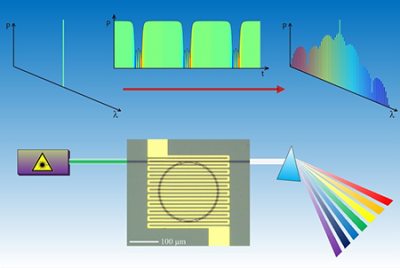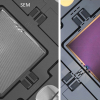
Researchers have solved a key obstacle in creating the underlying technology for miniature optical sensors to detect chemicals and biological compounds, high-precision spectroscopy, ultra-stable microwave sources, and optical communications systems that transmit greater volumes of information with better quality.
The technology is based on the reliable generation and control of laser pulses containing a number of equally spaced frequencies called “comb lines”. By precisely controlling these frequency combs, including their initiation, coherence and spacing, researchers hope to create miniature optical devices using ring-shaped “microresonators”.
A research team at Purdue University has demonstrated prototypes, and new findings are described in Nature Photonics. The findings, together with those in another paper published earlier in Laser and Photonics Reviews, detail an optical phenomenon called “dark pulses” and show how to precisely control the comb generation.
Whereas conventional optical communication requires many lasers to transmit various frequencies, the new devices might require only a single light source, which is then transformed to emit light at multiple wavelengths. Such an innovation would reduce cost and make possible more compact optical systems small enough to fit on electronic chips, said Minghao Qi (pronounced Ming-how Chee), an associate professor of electrical and computer engineering.
“Say you have 40 channels. If we have 40 individual lasers, together with their individual control circuitry on a single telecommunication chip, then your cost is high. If one of the lasers goes down you have to replace the entire chip. You could achieve significant cost reduction if you were able to use just one laser to create multiple wavelengths to drive different channels,” he said.
The lead author of the Nature Photonics paper is postdoctoral research associate Xiaoxiao Xue. The microresonators accumulate optical power, and enhance an otherwise weak effect of “optical non-linear interaction”, which allows for the generation of numerous frequencies, Xue said. The ring-shaped device has a radius of about 100 µm and is fabricated from silicon nitride, a material compatible with silicon material widely used for electronics.
Researchers had previously created “bulk optics” systems, which use mirrors, lenses and other optical components arranged on a vibration-dampened table several feet long to convert and transmit the pulsed signals. However, these systems are far too large to be practical, and the Purdue researchers miniaturised the technology, creating microresonators small enough to fit on a computer chip. However, miniaturising the apparatus poses challenges because it is difficult to retain a property of optical fibre called “anomalous dispersion”, which makes the high frequency components of a pulse travel faster than the lower ones, and was previously considered necessary to generate the frequency combs.
“To achieve anomalous dispersion in silicon nitride microresonators ordinarily requires very thick film, which is susceptible to cracking and not practical to manufacture”, said Andrew M. Weiner, the Scifres Family Distinguished Professor of Electrical and Computer Engineering. “Here, we show how to generate the combs without anomalous dispersion, so we potentially no longer need the thick films.”
Dark pulses can be envisioned as a shutter that is normally open to allow light to pass through, but can quickly close to block the light and then open again to turn the light back on. The entire process can be as fast as 1–2 ps.
The technology could bring miniature optical sensors to detect and measure chemicals, ultra-precise spectroscopy for laboratory research and optical communications systems that transmit greater volumes of information with better quality and at lower cost. The microresonators can work not only in the NIR range required for optical communications but also in the visible and mid-IR.
“If you had a comb you could probe molecules at multiple wavelengths at once, so it’s faster and provides more information about the molecule”, Xue said.










